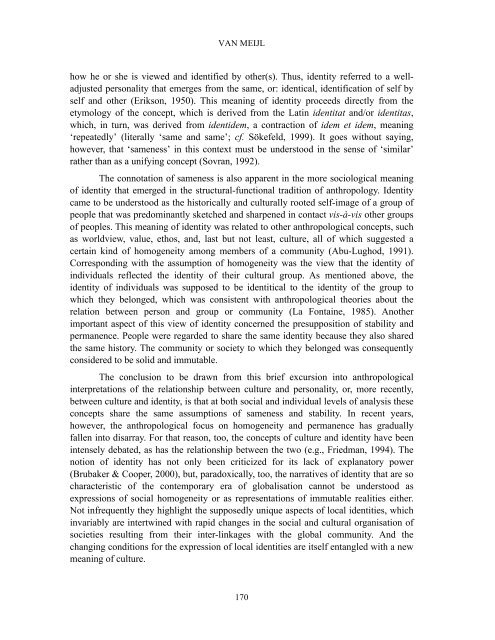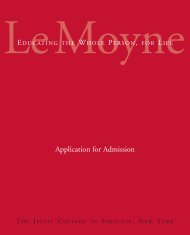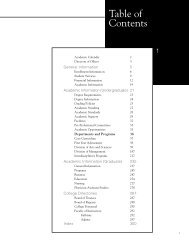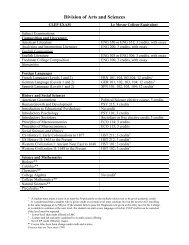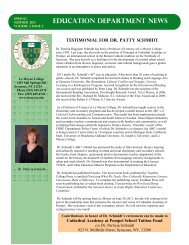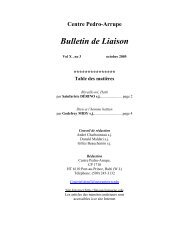165 culture and identity in anthropology: reflections on 'unity'
165 culture and identity in anthropology: reflections on 'unity'
165 culture and identity in anthropology: reflections on 'unity'
You also want an ePaper? Increase the reach of your titles
YUMPU automatically turns print PDFs into web optimized ePapers that Google loves.
VAN MEIJLhow he or she is viewed <str<strong>on</strong>g>and</str<strong>on</strong>g> identified by other(s). Thus, <str<strong>on</strong>g>identity</str<strong>on</strong>g> referred to a welladjustedpers<strong>on</strong>ality that emerges from the same, or: identical, identificati<strong>on</strong> of self byself <str<strong>on</strong>g>and</str<strong>on</strong>g> other (Eriks<strong>on</strong>, 1950). This mean<str<strong>on</strong>g>in</str<strong>on</strong>g>g of <str<strong>on</strong>g>identity</str<strong>on</strong>g> proceeds directly from theetymology of the c<strong>on</strong>cept, which is derived from the Lat<str<strong>on</strong>g>in</str<strong>on</strong>g> identitat <str<strong>on</strong>g>and</str<strong>on</strong>g>/or identitas,which, <str<strong>on</strong>g>in</str<strong>on</strong>g> turn, was derived from identidem, a c<strong>on</strong>tracti<strong>on</strong> of idem et idem, mean<str<strong>on</strong>g>in</str<strong>on</strong>g>g‘repeatedly’ (literally ‘same <str<strong>on</strong>g>and</str<strong>on</strong>g> same’; cf. Sökefeld, 1999). It goes without say<str<strong>on</strong>g>in</str<strong>on</strong>g>g,however, that ‘sameness’ <str<strong>on</strong>g>in</str<strong>on</strong>g> this c<strong>on</strong>text must be understood <str<strong>on</strong>g>in</str<strong>on</strong>g> the sense of ‘similar’rather than as a unify<str<strong>on</strong>g>in</str<strong>on</strong>g>g c<strong>on</strong>cept (Sovran, 1992).The c<strong>on</strong>notati<strong>on</strong> of sameness is also apparent <str<strong>on</strong>g>in</str<strong>on</strong>g> the more sociological mean<str<strong>on</strong>g>in</str<strong>on</strong>g>gof <str<strong>on</strong>g>identity</str<strong>on</strong>g> that emerged <str<strong>on</strong>g>in</str<strong>on</strong>g> the structural-functi<strong>on</strong>al traditi<strong>on</strong> of <str<strong>on</strong>g>anthropology</str<strong>on</strong>g>. Identitycame to be understood as the historically <str<strong>on</strong>g>and</str<strong>on</strong>g> culturally rooted self-image of a group ofpeople that was predom<str<strong>on</strong>g>in</str<strong>on</strong>g>antly sketched <str<strong>on</strong>g>and</str<strong>on</strong>g> sharpened <str<strong>on</strong>g>in</str<strong>on</strong>g> c<strong>on</strong>tact vis-à-vis other groupsof peoples. This mean<str<strong>on</strong>g>in</str<strong>on</strong>g>g of <str<strong>on</strong>g>identity</str<strong>on</strong>g> was related to other anthropological c<strong>on</strong>cepts, suchas worldview, value, ethos, <str<strong>on</strong>g>and</str<strong>on</strong>g>, last but not least, <str<strong>on</strong>g>culture</str<strong>on</strong>g>, all of which suggested acerta<str<strong>on</strong>g>in</str<strong>on</strong>g> k<str<strong>on</strong>g>in</str<strong>on</strong>g>d of homogeneity am<strong>on</strong>g members of a community (Abu-Lughod, 1991).Corresp<strong>on</strong>d<str<strong>on</strong>g>in</str<strong>on</strong>g>g with the assumpti<strong>on</strong> of homogeneity was the view that the <str<strong>on</strong>g>identity</str<strong>on</strong>g> of<str<strong>on</strong>g>in</str<strong>on</strong>g>dividuals reflected the <str<strong>on</strong>g>identity</str<strong>on</strong>g> of their cultural group. As menti<strong>on</strong>ed above, the<str<strong>on</strong>g>identity</str<strong>on</strong>g> of <str<strong>on</strong>g>in</str<strong>on</strong>g>dividuals was supposed to be identitical to the <str<strong>on</strong>g>identity</str<strong>on</strong>g> of the group towhich they bel<strong>on</strong>ged, which was c<strong>on</strong>sistent with anthropological theories about therelati<strong>on</strong> between pers<strong>on</strong> <str<strong>on</strong>g>and</str<strong>on</strong>g> group or community (La F<strong>on</strong>ta<str<strong>on</strong>g>in</str<strong>on</strong>g>e, 1985). Anotherimportant aspect of this view of <str<strong>on</strong>g>identity</str<strong>on</strong>g> c<strong>on</strong>cerned the presuppositi<strong>on</strong> of stability <str<strong>on</strong>g>and</str<strong>on</strong>g>permanence. People were regarded to share the same <str<strong>on</strong>g>identity</str<strong>on</strong>g> because they also sharedthe same history. The community or society to which they bel<strong>on</strong>ged was c<strong>on</strong>sequentlyc<strong>on</strong>sidered to be solid <str<strong>on</strong>g>and</str<strong>on</strong>g> immutable.The c<strong>on</strong>clusi<strong>on</strong> to be drawn from this brief excursi<strong>on</strong> <str<strong>on</strong>g>in</str<strong>on</strong>g>to anthropological<str<strong>on</strong>g>in</str<strong>on</strong>g>terpretati<strong>on</strong>s of the relati<strong>on</strong>ship between <str<strong>on</strong>g>culture</str<strong>on</strong>g> <str<strong>on</strong>g>and</str<strong>on</strong>g> pers<strong>on</strong>ality, or, more recently,between <str<strong>on</strong>g>culture</str<strong>on</strong>g> <str<strong>on</strong>g>and</str<strong>on</strong>g> <str<strong>on</strong>g>identity</str<strong>on</strong>g>, is that at both social <str<strong>on</strong>g>and</str<strong>on</strong>g> <str<strong>on</strong>g>in</str<strong>on</strong>g>dividual levels of analysis thesec<strong>on</strong>cepts share the same assumpti<strong>on</strong>s of sameness <str<strong>on</strong>g>and</str<strong>on</strong>g> stability. In recent years,however, the anthropological focus <strong>on</strong> homogeneity <str<strong>on</strong>g>and</str<strong>on</strong>g> permanence has graduallyfallen <str<strong>on</strong>g>in</str<strong>on</strong>g>to disarray. For that reas<strong>on</strong>, too, the c<strong>on</strong>cepts of <str<strong>on</strong>g>culture</str<strong>on</strong>g> <str<strong>on</strong>g>and</str<strong>on</strong>g> <str<strong>on</strong>g>identity</str<strong>on</strong>g> have been<str<strong>on</strong>g>in</str<strong>on</strong>g>tensely debated, as has the relati<strong>on</strong>ship between the two (e.g., Friedman, 1994). Thenoti<strong>on</strong> of <str<strong>on</strong>g>identity</str<strong>on</strong>g> has not <strong>on</strong>ly been criticized for its lack of explanatory power(Brubaker & Cooper, 2000), but, paradoxically, too, the narratives of <str<strong>on</strong>g>identity</str<strong>on</strong>g> that are socharacteristic of the c<strong>on</strong>temporary era of globalisati<strong>on</strong> cannot be understood asexpressi<strong>on</strong>s of social homogeneity or as representati<strong>on</strong>s of immutable realities either.Not <str<strong>on</strong>g>in</str<strong>on</strong>g>frequently they highlight the supposedly unique aspects of local identities, which<str<strong>on</strong>g>in</str<strong>on</strong>g>variably are <str<strong>on</strong>g>in</str<strong>on</strong>g>tertw<str<strong>on</strong>g>in</str<strong>on</strong>g>ed with rapid changes <str<strong>on</strong>g>in</str<strong>on</strong>g> the social <str<strong>on</strong>g>and</str<strong>on</strong>g> cultural organisati<strong>on</strong> ofsocieties result<str<strong>on</strong>g>in</str<strong>on</strong>g>g from their <str<strong>on</strong>g>in</str<strong>on</strong>g>ter-l<str<strong>on</strong>g>in</str<strong>on</strong>g>kages with the global community. And thechang<str<strong>on</strong>g>in</str<strong>on</strong>g>g c<strong>on</strong>diti<strong>on</strong>s for the expressi<strong>on</strong> of local identities are itself entangled with a newmean<str<strong>on</strong>g>in</str<strong>on</strong>g>g of <str<strong>on</strong>g>culture</str<strong>on</strong>g>.170


